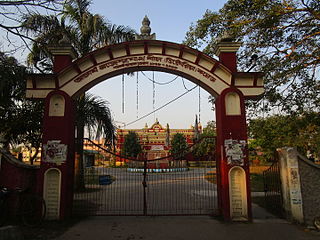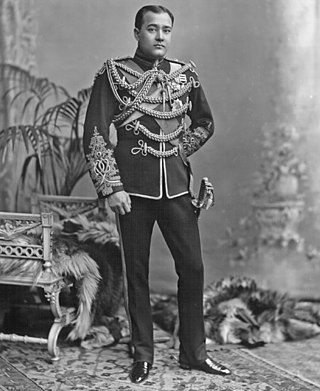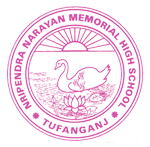
Cooch Behar district is a district of the Indian state of West Bengal.

Cooch Behar, also known as Koch Bihar, was a princely state in India during the British Raj. The state was placed under the Bengal States Agency, part of the Eastern States Agency of the Bengal Presidency. It was located south of the Himalayan kingdom of Bhutan, in present-day West Bengal.

Cooch Behar, or Koch Bihar, is a city and a municipality lying on the bank of River Torsa in the Indian state of West Bengal. It is the headquarters of the Cooch Behar district. It is in the foothills of the Eastern Himalayas at 26°22′N89°29′E. Cooch Behar is a planned city. Being one of the main tourist destinations of West Bengal, housing the Cooch Behar Palace and Madan Mohan Temple, it has been declared a heritage city. It is the maternal home of Maharani Gayatri Devi of Jaipur State.
Cooch Behar is the district headquarters and the largest town of Cooch Behar district in the Indian state of West Bengal. The name Cooch Behar is derived from two words—Cooch, a corrupted form of the word Koch, the name of the Koch tribes, and the word behar is derived from vihara meaning land, Koch Behar means land of the Koches.

Cooch Behar Palace is a landmark in Cooch Behar city, West Bengal. It was designed in the Italian Renaissance architecture style and was built in 1887, during the reign of Maharaja Nripendra Narayan of Koch dynasty. It is currently a museum.

Jenkins School is a boys school in the Indian state of West Bengal. It was established in 1861 in the town of Cooch Behar.

Acharya Brojendra Nath Seal College popularly known as ABN Seal College, earlier Victoria College, is a state-government owned co-educational college in Cooch Behar, West Bengal, India. It was established in 1888 and offers undergraduate and postgraduate education. The college is affiliated to the Cooch Behar Panchanan Barma University and accredited as A+ by NAAC. The college has been conferred the "Centre of Excellence" status by the University Grants Commission.

Nripendra Narayan Government High School is a secondary school located in Debiganj, Debiganj Upazila, Panchagarh District, Bangladesh. It was founded in 1906 by Maharaja Nripendra Narayan. This school is also known as Debiganj N.N. Govt. High School. Secondary School Certificate examination under Dinajpur Education Board.
Maharaj Kumar Hitendra Singh Narayan, commonly anglicised as Prince Hitendra Narayan, played first-class cricket for Somerset in 1909 and 1910. He later played in first-class matches for teams brought together by his brother, the Maharaja of Cooch Behar.

Maharaja Shri Sir Jitendra Narayan Bhup Bahadur was the Maharaja of Cooch-Behar, India, from September 1913 until his death in December 1922.

The Raash-Chakra or The Holy Wheel is a structure built during the Raash Mela that is held in honour of Lord Madan Mohan, the avatar of Lord Krishna in Cooch Behar, India. From the time of the Maharajas, the Raash-Chakra in Cooch Behar is made by Hindu artisans and Muslim artisans. The Muslim artisans are of a family of ghughumari area since three generations. Before that it was built by other artisans. Every year the Raash-Chakra built by a group of artisans on behalf of the Debuttor Trust Board which organizes the Lord Madan Mohan Raash Utsav. The Raash Mela is held centering around the Lord Madan Mohan Raash Utsav at Madanmohan Temple and the Fair spreads out around the Temple in its adjacent areas up to Rash Mela Ground, Cooch Behar.

Sunity DeviCIE was the Maharani of the princely state of Cooch Behar, British India.

Maharaja Nripendra Narayan was the Maharaja of the princely state of Cooch Bihar, India, from 1863 to 1911.

Sunity Academy is a higher secondary girls' school in Cooch Behar, West Bengal, India.
Cooch Behar State Railway (CBSR) was a 2 ft 6 in narrow-gauge railway from Jayanti to Lalmonirhat in the Indian state of West Bengal.

Cooch Behar railway station serves Cooch Behar in Cooch Behar district in the Indian state of West Bengal.

Nripendra Narayan Memorial High School is the oldest educational institution in Tufanganj subdivision. It is at the center of the town and is of historical importance regarding education in pre-independent India. The school was established in 1916 by Maharaja Jitendra Narayan, the Maharaja of Cooch Behar and is named after the late Maharaja Nripendra Narayan.
Raj Rajendra Narayan Bhup Bahadur (1882–1913), eldest son of Nripendra Narayan, was Maharaja of Cooch Behar, West Bengal, India.
Narendra Narayan (1841–1863) was the Maharaja of princely state of Koch Bihar, India, from 1847 to 1863.
The Narendra Narayan Park is a botanical garden located in Cooch Behar town of West Bengal. It was established in 1894. It is named after erstwhile ruler of princely state of Cooch Behar, Shri Narendra Narayan. It was founded by Maharaja Nripendra Narayan, who named it after his father. It covers an area of 5.7 hectares including 1 hectare of water body. Its chief objectives are recreation and botanical studies.














